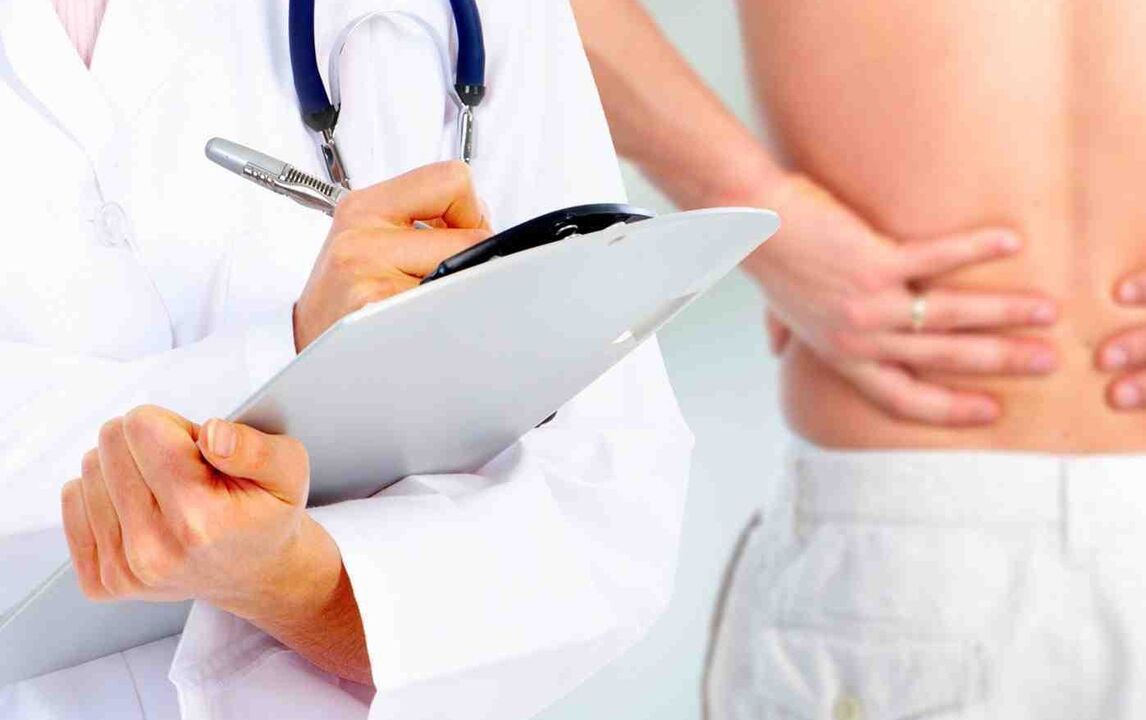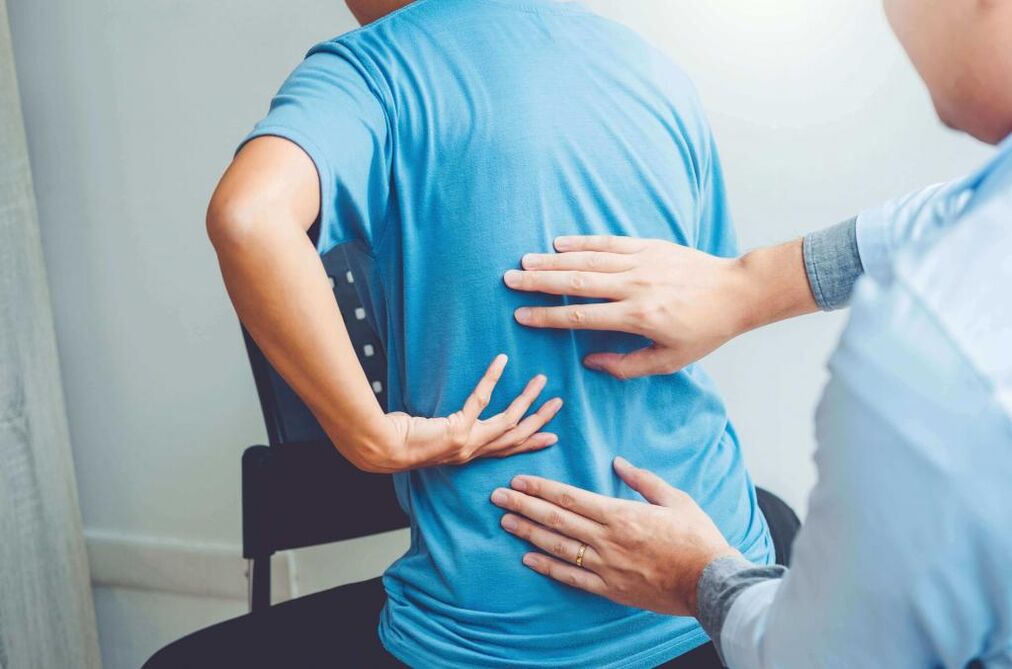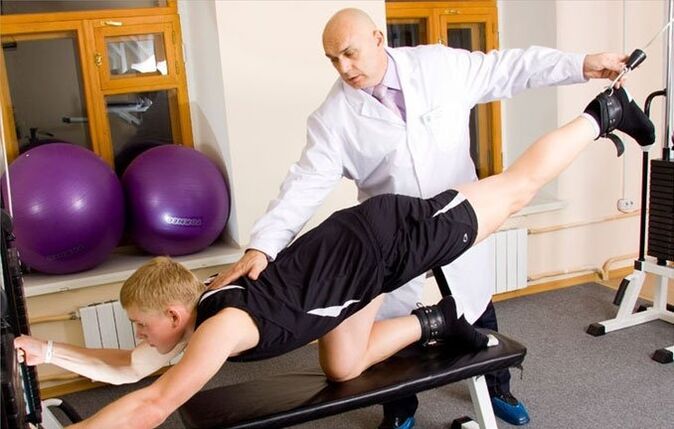So, let's consider the causes of pain syndrome in the lumbar spine region in turn:
- Spine disease. The rarest but most serious conditions that cause back pain include Bechterew's disease. In this disease, the vertebrae grow together, calcium deposits in the ligaments, and the affected back loses mobility. Features of pain in this pathology - increased pain at rest, prolonged lying; restricted movement in the lumbar region. The disorder usually begins at a young age and may have a genetic predisposition.
- The spine is curved. Kyphosis and asymmetric scoliosis (two types of curvature) cause spasms of the muscles deep in the spine. In most cases, the pain syndrome appears in the middle to late stages of the disease, manifesting more intensely at the end of the day, with fatigue. This pathology begins in childhood and may also have a genetic predisposition.
- Osteoporosis is a decrease in bone mineral density, resulting in weak bones and frequent fractures.
- Osteochondrosis - thinning of the intervertebral discs, leading to herniated discs and hernias in advanced stages - is the most common cause of back pain. Additionally, the pain is exacerbated when changing positions: getting up from a sitting position, trying to lie on your stomach, turning around, bending over.
- Spine injuries, sprains and bruises, fractures.
- Spondylolisthesis - the displacement of the lumbar spine relative to the vertebrae below it. The pain is located in the middle of the back, felt from the legs, and is accompanied by numbness and/or weakness that is worse when standing or bending over.
- Fibromyalgia is a pathology that causes pain in muscles, ligaments, and tendons. Pain and stiffness in various parts of the body that worsens when touched. Patients often complain of poor sleep. Most common in women 20-50 years old.
- Soft tissue and kidney damage. Severe, severe pain from a diseased kidney is characteristic of urolithiasis. Pain can occur anywhere on a person. Another condition with uncomfortable symptoms in the lower back is pyelonephritis.
- Infections or infections of the spine and spinal cord, such as osteomyelitis, discitis, epidural abscesses. Pain from this cause progresses and does not depend on the patient's position or activity. Sometimes fever or night sweats.
- Local inflammatory processes such as appendicitis or cholecystitis.
There are three types of low back pain: local, radiating, and reflex. Localized pain is felt in the same location as its cause, and this type of pain is most common in lower back syndromes. In this case, the most common causes are osteochondrosis of the spine, degeneration of the intervertebral discs, and stretching or spasms of the muscles deep in the spine.
Radiating pain is a dull pain that radiates most often to the legs and just to the feet. This may be accompanied by osteochondrosis in the stage of disc herniation, osteoarthritis or degeneration of the deep spinal muscles and hemodynamic disturbances along the sciatic nerve.

Referred pain usually means that the cause of the syndrome is in the internal organs. For example, with heart disease, the arms, back, and shoulder blades can be injured. The pain is reflected from the internal organs to the waist, with the characteristics of deep pain, independent of movement.
Low back pain in men and women
In women, back pain may be the result of a gynecological disorder. In this case, the discomfort is dull, pulling. Among these diseases in women - adnexitis, torsion of ovarian cysts, salpingo-oophoritis, uterine fibroids and endometritis can manifest as low back pain. Pregnancy, due to increased load on the spine and weight gain, often causes back pain and can also occur during menopause. With an ectopic pregnancy, back pain can also occur - in this case, it's unbearable.
The cause of low back pain in men is usually caused by excessive exercise, weightlifting, spinal injuries, but it can also be a disease specific to men - prostatitis or epididymitis. The pathological features of the prostate are pulling, pain, and dysuria.

Diagnosis and Treatment of Low Back Pain
Depending on the cause of back pain, different specialists are involved in its treatment. If it is a spinal pathology then you need to contact a sports therapist, if it is a visceral pathology a therapist, gastroenterologist, gynecologist, urologist, if the pathology is a rheumatologist, a rheumatologist, in the lower bodycancer cases and see an oncologist.
First, to make a diagnosis, the doctor interviews the patient to find out the nature of the pain: whether it is acute or dull, whether it is pulling, whether it depends on movement, activity, position, whether it is accompanied by other symptoms or not. After the oral questioning, the physician examines the patient, palpating the muscles of the lower back, spine, and extremities. Additional tests, laboratory tests, X-rays, MRI, tissue biopsy, EMG may be required.
For treatment, also depending on the disease, various means are used. Pain relievers and anti-inflammatory drugs are most commonly used in cases of deep spinal muscle spasm and inflammation caused by factors such as osteochondrosis, scoliosis, spondyloarthropathy, but they do not directly affect the cause of the pain syndrome, eliminating only itperformance, there are many side effects. To address the cause of back pain, the following steps are recommended:
- Strength and stretch-style decompression exercises to relieve spasms and pain in the deep muscles of the spine,
- Therapeutic massage to relieve muscle tension in pathological areas,
- cryotherapy to relieve local pain,
- Physiotherapy methods such as shock wave therapy, acupuncture, instrument massage, balneotherapy (mud application, contrast therapy, etc. ),
Prevention of low back pain
The main prevention of various diseases of the musculoskeletal system is the prevention of the development of malnutrition, that is, the weakening of the muscles of the deep layers of the spine, on which the nutrition of the vertebrae and intervertebral discs depends. Strengthening the muscles of the spine should be done regularly, and the most modern method is the author's method, which is to use a strength and decompression type simulator. But exercises can also be done without simulators, of which there are many. Gymnastic breaks at work are important, especially the sedentary type, i. e. every 3-4 hours, dedicate at least 15 minutes to it, walk several times a week for 1. 5-2 hours and recharge in the morning.

Depending on the method, a few simple exercises on a regular basis are recommended to prevent back pain:
- Back relaxation (known as the exercise "cat"): on all fours, inhale - head up, back bent down; exhale - head down, round back;
- Stretching step (in yoga, this exercise is called "Pigeon Pose"): In the all-fours pose, you need to bring one knee forward, foot inward, and the other leg back, lying prone on your thigh, palms under your shoulders. For a more effective stretch, move the arms diagonally to the sides and lower the head, stopping for 5-10 seconds. Return to the starting position and repeat on the other side.
- Lie on your back with your pelvis raised and your legs bent at your knees;
- Press: Supine position, bend knees, bend elbows with both arms, hold the back of the head, when exhaling, the chin is close to the chest, and the shoulder blades are raised;
- Knee Press: Lie on your stomach, pull your knees toward your chest in turn, press your hands to your body when you exhale, or do it when hanging.
All of these exercises are simple enough that 10-15 repetitions of each exercise are sufficient. With regular practice, they will give you invaluable benefits!
Among other tips, use a comfortable mattress to relax your back muscles at night. If you spend a lot of time driving or working in front of a computer, be aware of proper body posture. The seats in the car should be height-adjustable and close to the steering wheel, and the backrest should be soft enough to accommodate bumps on rough roads.
Elbows should be bent at right angles when working or studying at the desk. The chair must have a backrest to support the lower back, and the appearance (along with it and the neck) should be straight or slightly up, but not down. The light falls correctly on the work surface of the table.
Remember, prevention is more important than cure!


























